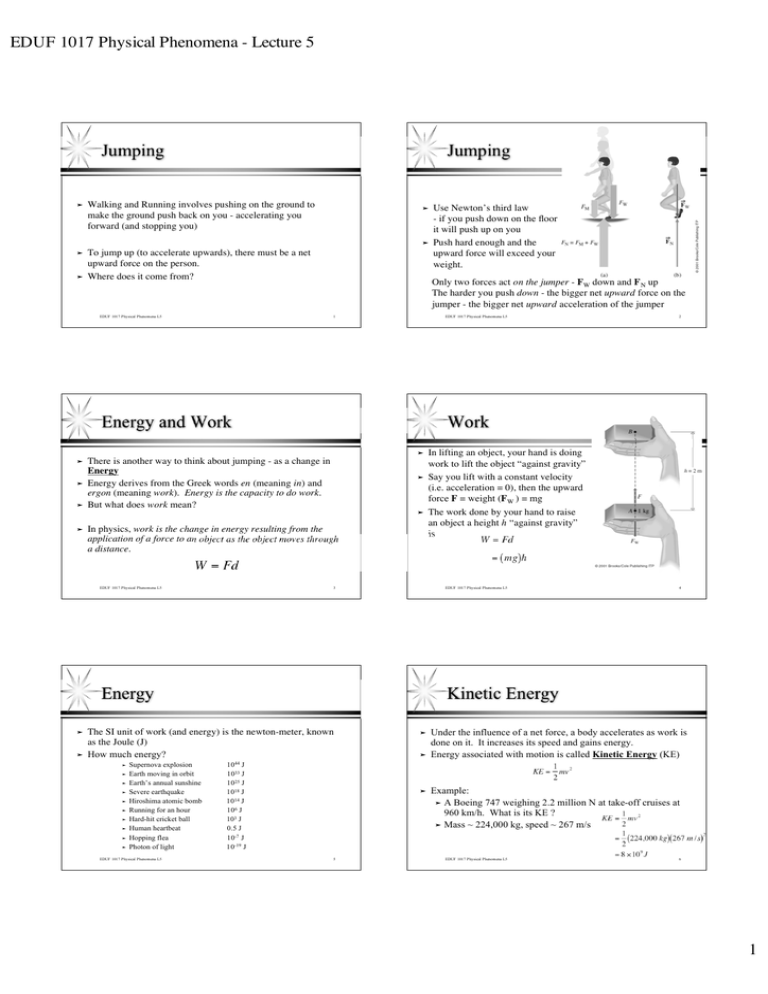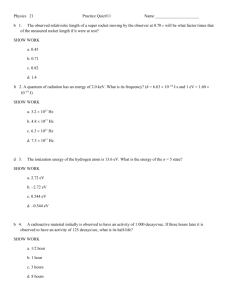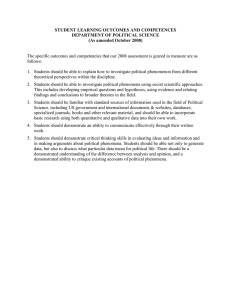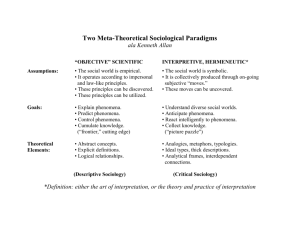Jumping Jumping Energy and Work Work Energy Kinetic Energy
advertisement

EDUF 1017 Physical Phenomena - Lecture 5 Jumping Jumping Walking and Running involves pushing on the ground to make the ground push back on you - accelerating you forward (and stopping you) To jump up (to accelerate upwards), there must be a net upward force on the person. Where does it come from? EDUF 1017 Physical Phenomena L5 Only two forces act on the jumper - FW down and F N up The harder you push down - the bigger net upward force on the jumper - the bigger net upward acceleration of the jumper 1 EDUF 1017 Physical Phenomena L5 Energy and Work There is another way to think about jumping - as a change in Energy Energy derives from the Greek words en (meaning in) and ergon (meaning work). Energy is the capacity to do work. But what does work mean? In physics, work is the change in energy resulting from the application of a force to an object as the object moves through a distance. EDUF 1017 Physical Phenomena L5 3 Supernova explosion Earth moving in orbit Earth’s annual sunshine Severe earthquake Hiroshima atomic bomb Running for an hour Hard-hit cricket ball Human heartbeat Hopping flea Photon of light EDUF 1017 Physical Phenomena L5 4 Kinetic Energy The SI unit of work (and energy) is the newton-meter, known as the Joule (J) How much energy? In lifting an object, your hand is doing work to lift the object “against gravity” Say you lift with a constant velocity (i.e. acceleration = 0), then the upward force F = weight (FW ) = mg The work done by your hand to raise an object a height h “against gravity” is EDUF 1017 Physical Phenomena L5 Energy 2 Work Use Newton’s third law - if you push down on the floor it will push up on you Push hard enough and the upward force will exceed your weight. 1044 J 1033 J 1025 J 1018 J 1014 J 106 J 103 J 0.5 J 10-7 J 10-19 J 5 Under the influence of a net force, a body accelerates as work is done on it. It increases its speed and gains energy. Energy associated with motion is called Kinetic Energy (KE) Example: A Boeing 747 weighing 2.2 million N at take-off cruises at 960 km/h. What is its KE ? Mass ~ 224,000 kg, speed ~ 267 m/s EDUF 1017 Physical Phenomena L5 6 1 EDUF 1017 Physical Phenomena - Lecture 5 Kinetic Energy Gravitational Potential Energy Your arm can do work on a cricket ball and increase the ball’s KE. It travels some distance and then crashes into the stumps, doing work on them and losing a corresponding amount of KE. The ball transports energy in the form of KE from one place to another EDUF 1017 Physical Phenomena L5 7 We have already calculated the work done in lifting an object a height h “against gravity” So Gravitational PE is Mechanical Energy of a system is the sum of KE and gravitational GPE of all its parts. If no additional forces (except gravity) are applied to a system, mechanical energy is conserved. This is a limited case of the more general concept of conservation of all forms of energy. 9 EDUF 1017 Physical Phenomena L5 Jumping Energy and Work and very closely related concepts. Work is a change in energy resulting from the application of a force Kinetic Energy (KE) Gravitational Potential Energy (GPE) If no additional forces are applied to a system, mechanical energy (KE + GPE) is conserved. How can pole vaulters jump so high? The pole provides a means of transforming almost all the jumper’s initial KE from his runup, into gravitational PE - i.e. into height. Once the jumper is off the ground, his run-up KE is converted into both gravitational PE and elastic PE of the pole. As the pole straightens again it gives up its elastic PE and hurls him even higher. EDUF 1017 Physical Phenomena L5 10 Summary 8 Mechanical Energy This retrievable stored energy is called Gravitational Potential Energy (PE or sometimes GPE) EDUF 1017 Physical Phenomena L5 Apparently it is possible to do work on a system when lifting it and not have it appear as KE. Energy is stored, waiting to be let loose. EDUF 1017 Physical Phenomena L5 Gravitational Potential Energy An object lifted against gravity still experiences the downward force of gravity when it is held up, but at rest. When no longer held up, it will obviously fall. Energy will appear as KE as it falls, but what’s happening while the object is held motionless in the air? 11 EDUF 1017 Physical Phenomena L5 12 2




